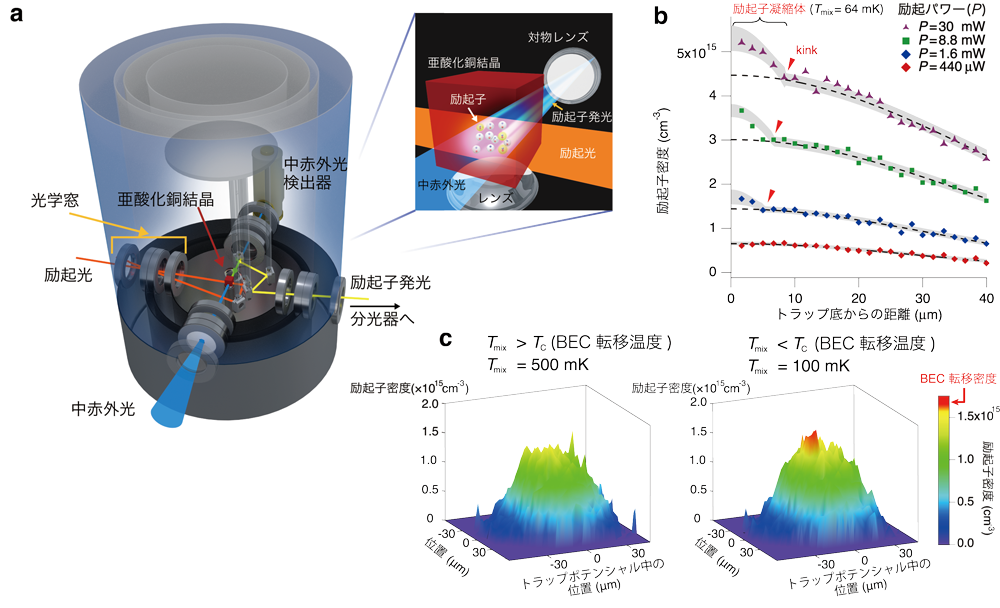Disclaimer: machine translated by DeepL which may contain errors.
Successful visualization of Bose-Einstein condensates of excitons at cryogenic temperatures
Yusuke Morita ( Assistant Professor, Department of Physics )Takataka Yoshioka ( Associate Professor, Graduate School of Engineering )Makoto Gokami, Professor, Department of Physics |

![]()
Excitons condense Bose-Einstein. This theoretical prediction was made in 1962. In the late 1970s, experiments using lasers to search for exciton BECs were actively conducted in many parts of the world. Excitons are light in mass and are expected to undergo a BEC transition at liquid 4He temperatures (4 K). On the other hand, excitons, which are quasiparticles and have short lifetimes, were hampered by the lack of cooling time. Excitons in cuprous oxide crystals are strongly suppressed in the annihilation process with luminescence and have an exceptionally long lifetime of up to μs, making them a good candidate for BEC realization. Later, however, it was experimentally found that the BEC transition density could not be maintained at 4 K due to the high frequency of inelastic collisions between excitons, and many researchers withdrew from the field.
In the meantime, we started our research in earnest by adopting a strategy to lower the BEC transition density ( 1017 cm-3 ) to suppress the loss due to inelastic collisions. First, we switched to a 3He refrigerator and succeeded in capturing the BEC transition in a strain-induced 3-D trap at 800 mK. However, the condensate immediately collapsed due to inelastic collisions caused by density increaseNote 1, so we decided to use a dilution refrigerator and cooled the crystal down to 40 mK to observe the condensate at a density of 1015 cm-3. However, many difficulties had to be overcome.
Excitons are cooled via phonon (crystal lattice vibration) emission. However, we found that below 1 K, the exciton can no longer emit phonons that act as a cooling agent, and cooling ceases. In the strong strain field, the interaction with unusual lattice vibrational modes is activated, and they aimed for cooling closer to the crystal temperature, achieving an unprecedentedly low exciton temperature of 100 mKNote 2.
Exciton observation at cryogenic temperatures usually uses luminescence. However, it was found that when the momentum of the exciton becomes even smaller, the momentum cannot be transferred to the photon, and the photon does not shine. The simple and highly sensitive detection method is not applicable to condensed matter observation.
We have developed a new mid-infrared absorption imaging method. This method utilizes the optical absorption process associated with the internal transition of excitons from the 1s state to the 2p state, and can accurately determine the exciton density. However, since the transition wavelength coincides with the peak of blackbody radiation at room temperature, a large amount of heat rays from the outside world enter the dilution refrigerator when a window that transmits mid-infrared light is installed. This is contrary to the usual practice of cryogenic experiments. We have realized imaging at a crystalline temperature of 64 mK by using an optical window material that prevents the inflow of heat rays as much as possible. The exciton temperature reached 170 mK, and the de Broglie wavelength of the exciton became about 100 times wider than the exciton Bohr radius (0.7 nm), and we finally observed the appearance of an exciton condensate at the bottom of a three-dimensional harmonic potential. The condensate is about 10 μm in size, and 6 × 106 excitons are condensed.
This achievement not only verified a theoretical prediction that had been pending for 60 years, but also led to the discovery of a new quantum condensate in a non-equilibrium liberated system. It is expected to provide an opportunity to dramatically deepen our understanding of the physics of the formation and dissipation of spontaneous quantum coherence.
The results of this research have been published in Y. Morita et al. Nature Communications 13, 5388 (2022).
(Note 1) K. Yoshioka et al., Nat. Commun. 2, 328 (2011).
(Note 2) K. Yoshioka et al., Phys. Rev. B 88, 041201(R) (2013).
(Press release, September 16, 2022)
Published in Faculty of Science News, January 2023.
Communicating to Faculty Research Student Frontiers>



